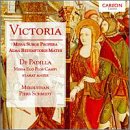| All Artists: Tomas Luis de Victoria, Juan Gutierrez de Padilla, Mixolydian Title: Victoria and the Music of the Imperial Spain Members Wishing: 0 Total Copies: 0 Label: Carlton Classics Release Date: 3/17/1998 Genre: Classical Styles: Opera & Classical Vocal, Chamber Music, Historical Periods, Baroque (c.1600-1750), Classical (c.1770-1830) Number of Discs: 1 SwapaCD Credits: 1 UPC: 723723245922 |
Search - Tomas Luis de Victoria, Juan Gutierrez de Padilla, Mixolydian :: Victoria and the Music of the Imperial Spain
 | Tomas Luis de Victoria, Juan Gutierrez de Padilla, Mixolydian Victoria and the Music of the Imperial Spain Genre: Classical
|
Larger Image |
CD Details |
CD ReviewsA simply gorgeous CD with important music of the Renaissance Craig Matteson | Ann Arbor, MI | 10/27/2005 (5 out of 5 stars) "This gorgeous disk has works by the great Tomás Luis de Victoria and the less well known Juan Gutièrrez de Padilla. Each is represented with a setting the ordinary of the Mass and a setting of the "Stabat Mater". While there are endless recordings of renaissance religious music, this recording is exceptionally beautiful. There are only fourteen voices, with the mix including six sopranos and four basses. The counter tenors and tenors have two each. The outer voices are over represented so they can individually sing more softly with perfect intonation. The sopranos sing with almost no vibrato, imitating the sound of the boys who would have sung these works in service during the sixteenth and seventeenth centuries.
Victoria is the older composer, born in 1548 and dying in August of 1611. He was born in Spain, was a priest, and trained in Rome. It is likely that he studied with the supreme master of renaissance polyphony, Palestrina. The school of composition that found its full flowering in Palestrina was heavily influenced by the music of Spain and it is interesting how the circle closed with Victoria and his influence on the music of Spain when he returned to his home country. One of the younger composers influenced by Victoria's powerful and expressive style of composition was de Padilla who was born in Spain around 1590. He was trained at the cathedral in his home town of Malaga and became the Maestro at Jerez in his early twenties. Eventually, he emigrated to New Spain (Mexico). He served as a singer, then assistant maestro, and in 1629 became the full maestro di capilla (music master of the chapel) in Puebla, Mexico at one of the richest cathedrals in the Spanish Empire (outside of Spain) and died there in 1664. If you are not accustomed yourself to listening to polyphonic music, let me give a bit of help. The word polyphonic simply means many voices. Think of a monk singing a chant. That is one voice. Eventually, since monks sang these many times each day, they doubled the voices at the octave so high and low voices could be accommodated. Later on, they doubled at the fifth and fourth, and later yet, they developed rules for controlling two melodies together. These rules are what we know as counterpoint (and the rules of counterpoint developed over time, as well). As music continued to develop, they put many voices together. Our modern notions of chords and harmony supporting a melody did not exist. You can't listen to this music in those terms and really hear what is going on. Yes, there are important structures that sort of sound like chords, but they don't function that way. You have to learn to hear things in layers. Not only do the various melodies matter, since it is sung music, the vowels and how they change add texture, the consonants are used to add rhythm and can provide wonderful effects as they enter in various voices at different moments. At times, as in the di Padilla mass on this disk, the composers used two choirs and played them off of and against each other to wonderful effect. You also can gain a lot by paying attention to the meaning of the words and how composers set them to accentuate their meaning. While you likely have some idea what a Mass is, and the ordinary is the part of the Mass that stays the same even as the proper changes according to the calendar, you may not know what the Stabat Mater is. It is a medieval poem representing Mary at the foot of the cross and is quite beautiful and composers have created powerful works for these wonderful words. It begins "The grieving Mother stood weeping beside the cross where her Son was hanging". The singing here is not prissy or over refined. There is power, wonderful color, and tremendous clarity of the words. Nothing is muddled or hard to hear, and the voices are beautiful. Superb job." |

 Track Listings (12) - Disc #1
Track Listings (12) - Disc #1